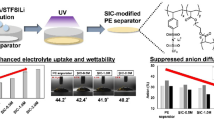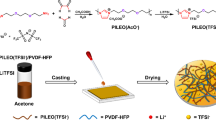Abstract
Single-ion conducting polymers have been widely reported in the literature as solid polymer electrolytes, but their low ionic conductivity has limited industrial applications at ambient temperature. Here, we employed a perfluoroalkyl sulfonamide-based single-ion conducting polymer-lithiated poly(perfluoroalkylsulfonyl)imide (LiPFSI) to promote the migration of free Li-ions and diminish cell polarization in lithium-ion batteries. After blending with Al2O3 powder, the LiPFSI/Al2O3 composite was coated on a commercial polyethylene separator. Adding the high surface energy of Al2O3 particles and the exceptional ionic conductivity of LiPFSI resulted in a LiPFSI/Al2O3 composite-coated separator with excellent wettability and low impedance. A LiFePO4/Li half-cell with this separator showed a highly improved charge–discharge cyclability up to 130 mAh/g that maintained 98% retention of the original reversible capacity after 220 charge–discharge cycles at a high current rate of 2 C (1 C = 170 mAh/g). Even at a high rate of 5 C, the cell capacity could be maintained above 100 mAh/g. Herein, we present a simple and effective method to optimize the separator with the LiPFSI/Al2O3 composite and thus improve the high rate charge–discharge performance of Li-ion batteries.






Similar content being viewed by others
References
Goodenough JB, Park KS (2013) The Li-ion rechargeable battery: a perspective. J Am Chem Soc 135:1167–1176
Etacheri V, Marom R, Elazari R, Salitra G, Aurbach D (2011) Challenges in the development of advanced Li-ion batteries: a review. Energy Environ Sci 4:243–3262
Scrosati B, Hassounab J, Sun YK (2011) Lithium-ion batteries. a look into the future. Energy Environ Sci 4:3287–3295
Armand M, Tarascon JM (2008) Building better batteries. Nature 451:652–657
Pereira JN, Costa CM, Mendez SL (2015) Polymer composites and blends for battery separators: state of the art, challenges and future trends. J Power Sources 281:378–398
Lee H, Yanilmaz M, Toprakci O, Fu K, Zhang X (2014) A review of recent developments in membrane separators for rechargeable lithium-ion batteries. Energy Environ Sci 7:3857–3886
Arora P, Zhang Z (2004) Battery separators. Chem Rev 104:4419–4462
Zhang Y, Wang Z, Xiang H, Shi P, Wang H (2016) A thin inorganic composite separator for lithium-ion batteries. J Membr Sci 509:19–26
Fang J, Kelarakis A, Lin YW, Kang CY, Yang MH, Cheng CL, Wang Y, Giannelis EP, Tsai LD (2011) Nanoparticle-coated separators for lithium-ion batteries with advanced electrochemical performance. Phys Chem Chem Phys 13:14457–14461
Li B, Li Y, Dai D, Chang K, Tang H, Chang Z, Wang C, Yuan X, Wang H (2015) Facile and nonradiation pretreated membrane as a high conductive separator for Li-ion batteries. ACS Appl Mater Interfaces 7:20184–20189
Lee JY, Lee YM, Bhattacharya B, Nho YC, Park JK (2009) Separator grafted with siloxane by electron beam irradiation for lithium secondary batteries. Electrochim Acta 54:4312–4315
Ryou MH, Lee Y, Park JK, Choi J (2011) Mussel-inspired polydopamine-treated polyethylene separators for high-power Li-ion batteries. Adv Mater 23:3066–3070
Kim JY, Lee Y, Lim DY (2009) Plasma-modified polyethylene membrane as a separator for lithium-ion polymer battery. Electrochim Acta 54:3714–3719
Zhang J, Liu Z, Kong Q, Zhang C, Pang S, Yue L, Wang X, Yao J, Cui G (2013) Renewable and superior thermal-resistant cellulose-based composite nonwoven as lithium-ion battery separator. ACS Appl Mater Interfaces 5:128–134
Cheruvally G, Kima JK, Choi JW, Ahn JH, Shin YJ, Manuel J, Raghavan P, Kim KW, Ahn HJ, Choi DS, Song CE (2007) Electrospun polymer membrane activated with room temperature ionic liquid: novel polymer electrolytes for lithium batteries. J Power Sources 172:863–869
Liu K, Liu W, Qiu Y, Kong B, Sun Y, Chen Z, Zhuo D, Lin D, Cui Y (2017) Electrospun core-shell microfiber separator with thermal-triggered flame-retardant properties for lithium-ion batteries. Sci Adv 3:e1601978
Zhu X, Jiang X, Ai X, Yang H, Cao Y (2005) A highly thermostable ceramic-grafted microporous polyethylene separator for safer lithium-ion batteries. ACS Appl Mater Interfaces 7:24119–24126
Jeong H S, Lee S Y (2011) Closely packed SiO2 nanoparticles/poly(vinylidene fluoride-hexafluoropropylene) layers-coated polyethylene separators for lithium-ion batteries. J Power Source 196:6716-6722
Jung YS, Cavanagh AS, Gedvilas L, Widjonarko NE, Scott ID, Lee SH, Kim GH, George SM, Dillon AC (2012) Improved functionality of lithium-ion batteries enabled by atomic layer deposition on the porous microstructure of polymer separators and coating electrodes. Adv Energy Mater 2:1022–1027
Choi J, Kim SH, Kim DW (2010) Enhancement of thermal stability and cycling performance in lithium-ion cells through the use of ceramic-coated separators. J Power Sources 195:6192–6196
Fu D, Luan B, Argue S, Bureau MN, Davidson IJ (2012) Nano SiO2 particle formation and deposition on polypropylene separators for lithium-ion batteries. J Power Sources 206:325–333
Choi ES, Lee SY (2011) Particle size-dependent, tunable porous structure of a SiO2/poly(vinylidene fluoride-hexafluoropropylene)-coated poly(ethylene terephthalate) nonwoven composite separator for a lithium-ion battery. J Mater Chem 21:14747–14754
Ma Q, Zhang H, Zhou CW, Zheng LP, Cheng PF, Nie J, Feng WF, Hu YS, Li H, Huang XJ, Chen LQ, Armand M, Zhou ZB (2016) A single lithium-ion conducting polymer electrolytes based on a super-delocalized polyanion. Angew Chem Int Ed 55:2521–2525
Porcarelli L, Shaplov AS, Salsamendi M, Nair JR, Vygodskii YS, Mecerreyes D, Gerbaldi C (2016) Single-ion block copoly(ionic liquid)s as electrolytes for all-solid state lithium batteries. ACS Appl Mater Interfaces 8:10350–10359
Bouchet R, Maria S, Meziane R, Aboulaich A, Lienafa L, Bonnet JP, Phan NT, Bertin D, Gigmes D, Devaux D, Denoyel R, Armand M (2013) Single-ion BAB triblock copolymers as highly efficient electrolytes for lithium-metal batteries. Nat Mater 12:452–457
Bernhard R, Latini A, Panero S, Scrosati B, Hassoun J (2013) Poly(ethylenglycol)dimethylether–lithium bis(trifluoromethanesulfonyl)imide, PEG500DME-LiTFSI, as high viscosity electrolyte for lithium ion batteries. J Power Sources 226:329–333
Shi Q, Xue L, Wei Z, Liu F, Du X, DesMarteau DD (2013) Improvement in LiFePO4–Li battery performance via poly(perfluoroalkylsulfonyl)imide (PFSI) based ionene composite binder. J Mater Chem A 1:15016–15021
Cao C, Li Y, Feng Y, Long P, An H, Qin C, Han J, Li S, Feng W (2017) A sulfonimide-based alternating copolymer as a single-ion polymer electrolyte for high-performance lithium-ion batteries. J Mater Chem A 5:22519–22526
Strauss E, Menkin S, Golodnitsky D (2017) On the way to high-conductivity single lithium-ion conductors. J Solid State Electrochem 21(1):1–27
Li J, Huang Y, Zhang S, Jia W, Wang X, Guo T (2017) Decoration of silica nanoparticles on polypropylene separator for lithium–sulfur batteries. ACS Appl Mater Interfaces 9:7499–7504
Xue L, DesMarteau DD, Pennington WT (1997) Perfectly staggered and twisted difluoromethylene groups in perfluoroalkyl chains: structure of M[C4F9SO2NSO2C4F9] (M = Na+, K+). Angew Chem Int Ed 36:1331–1333
Wei Z, Xue L, Nie F, Sheng J, Shi Q, Zhao X (2014) Study of sulfonated polyether ether ketone with pendant lithiated fluorinated sulfonic groups as ion conducting binder in lithium-ion batteries. J Power Sources 256:28–31
Qin D, Xue L, Du B, Wang J, Nie F, Wen L (2015) Flexible fluorine containing ionic binders to mitigate the negative impact caused by the drastic volume fluctuation from silicon nano-particles in high capacity anodes of lithium-ion batteries. J Mater Chem A 3:10928–10934
Shi Q, Xue L, Qin D, Du B, Wang J, Chen L (2014) Single ion solid-state composite electrolytes with high electrochemical stability based on a poly(perfluoroalkylsulfonyl)-imide ionene polymer. J Mater Chem A 2:15952–15957
Bruce PG, Vincent CA (1978) Steady-state current flow in solid binary electrolyte cells. J Electroanal Chem 225:1–17
Zhang Z, Hu L, Wu H, Weng W, Koh M, Redfern PC, Curtissb LA, Aminead K (2013) Fluorinated electrolytes for 5 V lithium-ion battery chemistry. Energy Environ Sci 6:1806–1810
Jin Z, Xie K, Hong X (2013) Synthesis and electrochemical properties of a perfluorinated ionomer with lithium sulfonyl dicyanomethide functional groups. J Mater Chem A 1:342–347
Mostafavi M, Douki T (2008) Radiation chemistry: from basics to applications in material and life science. EDP Sciences, Les Ulis
Zhu Y, Wang F, Liu L, Xiao S, Chang Z, Wu Y (2013) Composite of a nonwoven fabric with poly(vinylidene fluoride) as a gel membrane of high safety for lithium ion battery. Energy Environ Sci 6:618–624
Yanilmaz M, Lu Y, Dirican M, Fu K, Zhang X (2014) Nanoparticle-on-nanofiber hybrid membrane separators for lithium-ion batteries via combining electrospraying and electrospinning techniques. J Membr Sci 456:57–65
Diederichsen KM, McShane EJ, McClosky BD (2017) Promising routes to a high Li+ transference number electrolyte for lithium ion batteries. ACS Energy Lett 2:2563–2575
Zhang X, Li Y, Khan SA, Fedkiw PS (2004) Inhibition of lithium dendrites by fumed silica-based composite electrolytes. J Electrochem Soc 151:A1257–A1263
Kim KJ, Park MS, Yim T, Yu JS, Kim YJ (2014) Electron beam-irradiated polyethylene membrane with improved electrochemical and thermal properties for lithium-ion batteries. J Appl Electrochem 44:345–352
Acknowledgements
The authors would like to thank Advanced Lithium-Ion Batteries Engineering Laboratory in Ningbo, the Institute of Material Technology & Engineering for the supplement of LiFeO4. This work was supported by Natural Science Foundation of Zhejiang Province (No. LY15B020003) and Ningbo Natural Science Foundation (No. 2015A610243).
Author information
Authors and Affiliations
Corresponding author
Ethics declarations
Conflict of interest
The authors declare no competing financial interest.
Rights and permissions
About this article
Cite this article
Li, D., Qin, D., Nie, F. et al. Enhancement of electrochemical performance of lithium-ion battery by single-ion conducting polymer addition in ceramic-coated separator. J Mater Sci 53, 11038–11049 (2018). https://doi.org/10.1007/s10853-018-2353-x
Received:
Accepted:
Published:
Issue Date:
DOI: https://doi.org/10.1007/s10853-018-2353-x




